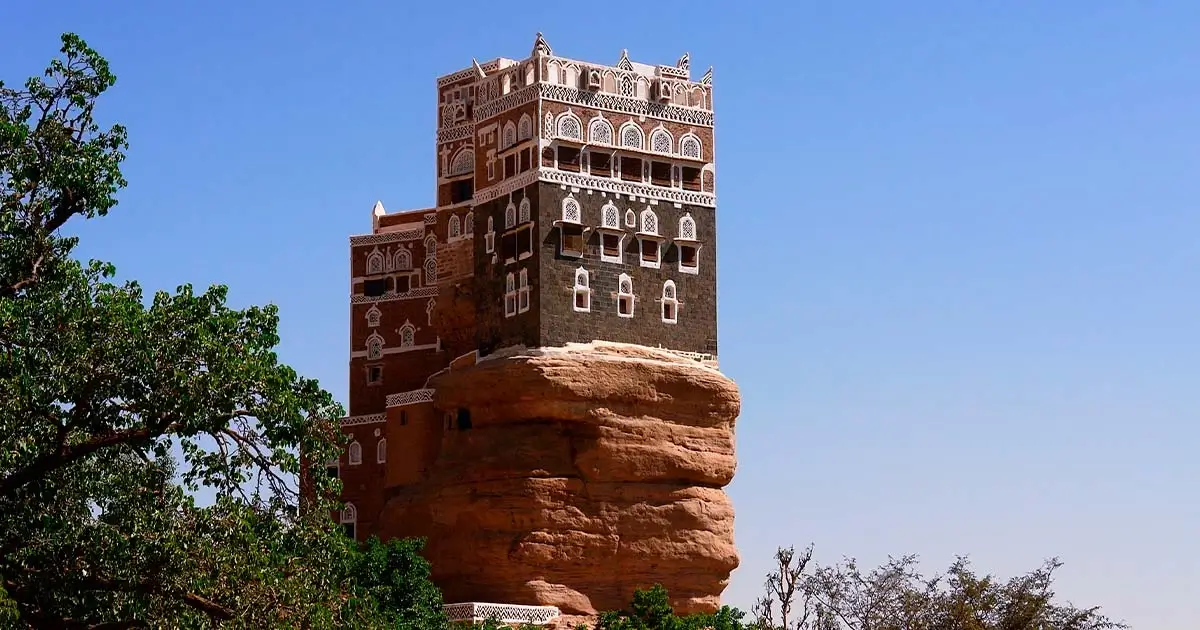Nestled in Yemen, the imposing Dar al-Hajar, dubbed Imam’s Rock Palace, stands as a showcase of the country’s rich history. Originally conceived as a modest summer retreat, this architectural marvel, carved seamlessly into the surrounding rock, transcends its humble origins.
A mere 10 miles (16 km) outside of Sanaʽa, Yemen’s capital, the palace was commissioned in the 1930s by Imam Yahya, the spiritual leader of the time, who chose this site for his seasonal abode.
Constructed over an older palace, the five-story residence boasts intricately patterned windows, earth-toned hues, and ornate exterior embellishments—a true embodiment of traditional Yemeni architecture. The palace’s significance extends beyond its aesthetic appeal; it serves as a vital water source with its deep well, showcasing the ingenuity of its builders.
Despite the region’s constrained tourism owing to conflicts, Dar al-Hajar stands resilient, offering both sanctuary to locals and a living reminder of Yemen’s architectural grandeur.
10 Facts of Dar al-Hajar
- Dar al-Hajar, also known as the Imam’s Rock Palace, was commissioned in the 1930s as a summer retreat.
- The palace is seamlessly carved into the natural rock formations of Yemen, showcasing a unique integration with the environment.
- Located just 10 miles from Sanaʽa, the capital of Yemen, the palace holds a strategic position in the landscape.
- Commissioned by Imam Yahya, the spiritual leader of the time, Dar al-Hajar serves as a reflection of his vision and influence.
- With five stories, the palace stands as an imposing architectural structure.
- The residence boasts intricately patterned windows, earth-toned hues, and ornate exterior embellishments, showcasing traditional Yemeni architecture.
- Beyond its aesthetic appeal, Dar al-Hajar functions as a vital water source with its deep well, highlighting the practical ingenuity of its builders.
- Despite regional conflicts limiting tourism, the palace remains resilient, providing sanctuary to locals.
- Dar al-Hajar is a living reminder of Yemen’s cultural and architectural grandeur.
- The palace stands as a historical haven, preserving the rich history and heritage of Yemen.
* * *
NEXT UP!
Unknown Language From 3,000 Years Ago Unearthed In Turkey
Bogazkoy-Hattusha, Turkey — During an excavation in Turkey’s UNESCO World Heritage Site, researchers and historians have made a captivating discovery — a new language. Archaeologists, engaged in research at the Boğazköy-Hattusha site, unearthed tablets inscribed with an unknown Indo-European language.
Situated in north-central Turkey, Boğazköy-Hattusha was once the bustling capital of the Hittite Empire, a formidable power in Western Asia during the Late Bronze Age (1650 to 1200 BC).
Over more than a century, diligent excavations guided by the German Archaeological Institute have been conducted at Boğazköy-Hattusha. Designated as a UNESCO World Heritage site in 1986, it has yielded over 30,000 clay tablets with cuneiform writing, recognized as UNESCO World Documentary Heritage in 2001.
* * *
READ MORE: This Ancient Maya City Was Hidden In The Jungle For More Than 1,000 Years
Interesting! Famed 5,300 Year Old Alps Iceman Was A Balding Middle-Aged Man With Dark Skin & Eyes
Enjoyed it? Please take a moment to show your support for Collective Spark.
We’d love to hear from you! If you have a comment about this article or if you have a tip for a future Collective Spark Story please let us know below in the comment section.

